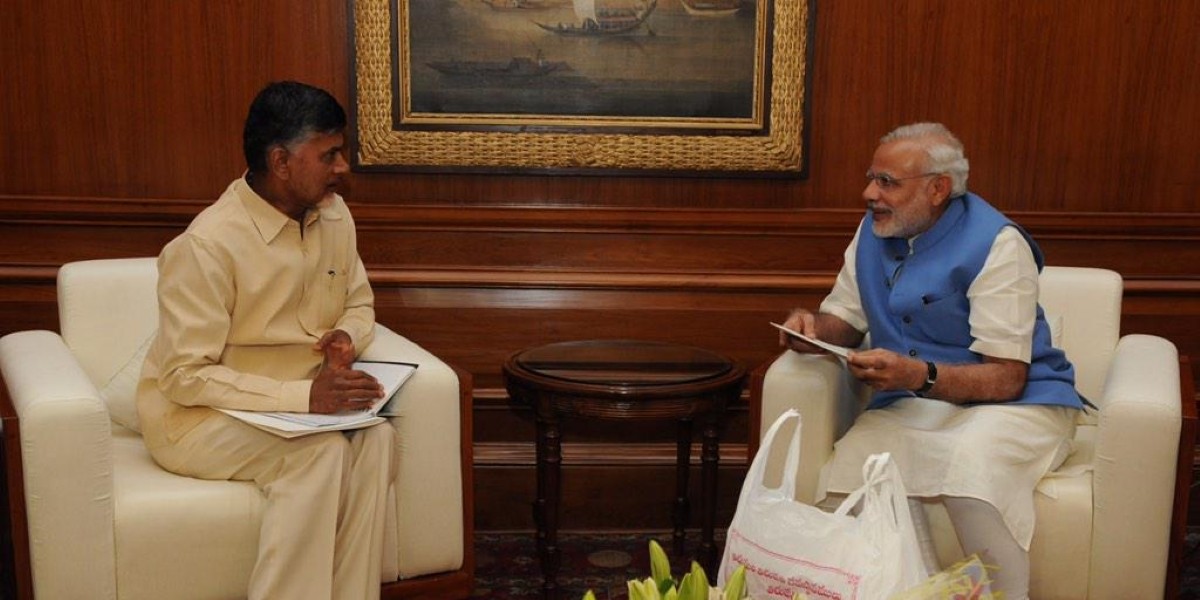Ahead of Narendra Modi’s visit, the state government is preparing to launch some of the several big-ticket projects already in the pipeline.
Published Apr 19, 2025 | 10:28 AM ⚊ Updated Apr 19, 2025 | 10:28 AM

File photo of Chief Minister Chandrababu Naidu inviting Prime Minister Narendra Modi to Amaravati in 2015. (Supplied)
Synopsis: Amaravati is set to restart construction with PM Modi visiting on 2 May. CM Chandrababu Naidu, backed by BJP and Jana Sena, is reviving his vision of a world-class capital. Phase I includes 92 projects worth ₹64,910 crore. With foreign funding and global architects, Amaravati aims to be a self-sustaining, green, tech-driven capital between Guntur and Vijayawada.
Amaravati is being decked up for Prime Minister Narendra Modi’s visit on 2 May. It will be the second time that the Prime Minister will be launching the construction works of Andhra Pradesh’s greenfield capital near the state Secretariat in Velagapudi.
He had earlier laid the foundation stone for Amaravati at Uddandarayunipalem in Guntur district on 22 October 2015, coinciding with Vijayadasami.
Determined to compensate for the loss of Hyderabad, following the bifurcation of Andhra Pradesh, Chief Minister N Chandrababu Naidu in his previous term began working towards building Amaravati.
Before moving from Hyderabad to Amaravati post-bifurcation, Naidu had remarked, “I am now more concerned about building a new capital for a state that has none.”
The people of Andhra Pradesh, still reeling from the trauma of the state’s division and the perceived injustice of the bifurcation process that heavily favoured Telangana, supported Naidu in his mission.
In a significant gesture at the 2015 foundation ceremony, Telangana Chief Minister K Chandrashekar Rao — widely seen as the architect of the bifurcation — attended the event at Naidu’s invitation, along with several dignitaries. However, Rao’s brief speech and presence touched a raw nerve among the audience.
Fast forward to 2025, and the construction of Amaravati is once again set to begin.
The TDP government, in it’s previous term (2014–2019) was unable to push the project forward meaningfully due to various initial hurdles. Toward the end of its tenure, in a politically controversial move, Chandrababu Naidu severed ties with the NDA in 2018, a year ahead of the elections. He had grown wary that his political rival, YS Jagan Mohan Reddy, was gaining ground with the demand for Special Category Status for Andhra Pradesh.
Naidu’s decision to first compromise on Special Category Status by accepting a special package, and later withdrawing from the BJP-led alliance for not granting the status, is now widely seen as a political miscalculation.
After suffering a defeat in the 2019 elections, Naidu’s Amaravati dream was pushed into cold storage by the new YSRCP government, which introduced the contentious “three-capital” plan. That plan failed to gain traction, and now, with the political tide turning – Naidu back in power with support from the BJP and Jana Sena Party – he is reviving the Amaravati vision, backed by the Prime Minister.
Naidu has reiterated that he never abandoned his Amaravati ambition. Just as he transformed Cyberabad into a global IT hub, he now wants to see a world-class capital emerge between Guntur and Vijayawada. Initially envisioned across 33,000 acres, the government is now considering acquiring an additional 30,000 acres to accommodate future needs.
Though there’s debate over whether Naidu can complete this grand vision, he is forging ahead. With limited resources in the state treasury and no direct central grants, Naidu is banking on external loans, with the Centre having cleared Andhra Pradesh’s proposal to raise foreign funds. His vision is to build Amaravati on a self-sustaining model, with the project funding itself over time.
Ahead of the prime minister’s visit, the state government is preparing to launch some of the several big-ticket projects already in the pipeline.
On 16 April, the Capital Region Development Authority (CRDA) has invited tenders for five iconic towers, four of which are the state secretariat and one for housing state government departments, for a total value of ₹4,668 crore. For Tower 1 and 2, the tender is for ₹1,897 crore while for towers 3 and 4, the value of the work is about ₹1,664 crore. The fifth tower is for housing state government departments whose value is ₹1,126 crore
Phase I of Amaravati, comprising 92 projects, is estimated to cost ₹64,910 crore. This includes infrastructure, housing, government buildings, and 19 iconic structures such as the Assembly building, a signature bridge, an NTR statue, a riverfront road along the Krishna, and major highway linkages. The iconic structures alone are projected to cost ₹16,871 crore.
Funding sources include, ₹13,400 crore (₹6,700 crore each) from World Bank and Asian Development Bank, ₹11,000 crore from HUDCO, and ₹5,000 crore from KfW Bank (Germany)
Inspired by Singapore, Amaravati is planned with 51 percent green cover, canal-based transportation, and global architectural standards. Noted architects like Norman Foster and international consultants from Singapore, China, and Japan are involved in the design.
(Edited by Sumavarsha)
